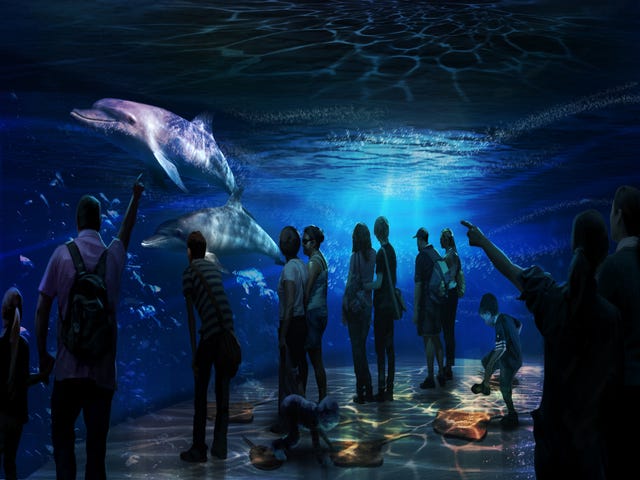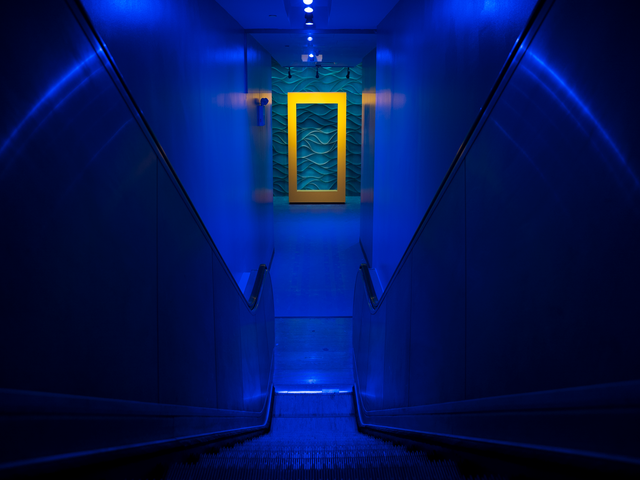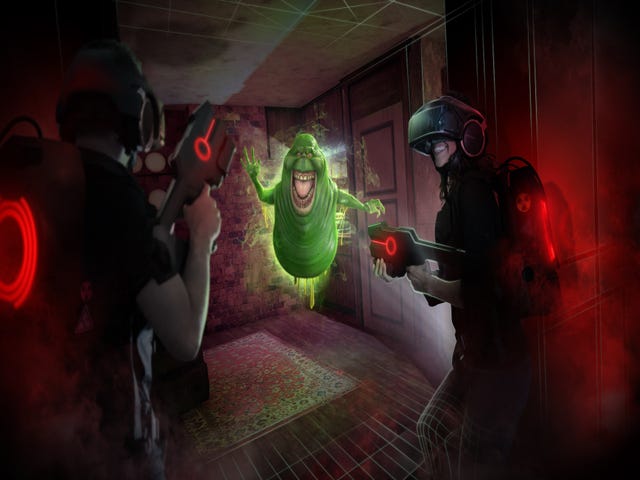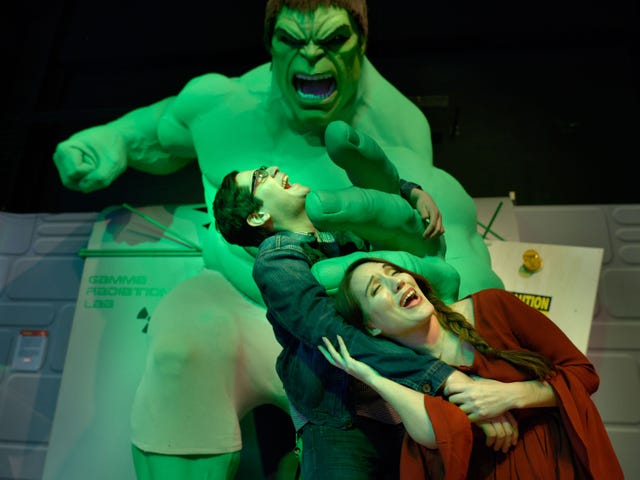It doesn't get any more bright lights, big city than Times Square. Yet in the heart of the Broadway theater district, just around the corner from where the famous ball drops every New Year's Eve, visitors are oohing and aahing at a massive whale, vicious squid, playful sea lions, and other marine life.
They are not at an urban aquarium. They are at National Geographic Encounter: Ocean Odyssey. Instead of bringing live animals to Midtown Manhattan, the unique entertainment experience transports guests to simulated deep-sea realms.

Opened last October, Ocean Odyssey uses digital media, technological trickery, and concepts borrowed from theme parks, live theater, museums, video games, and other disciplines. The fun begins even before visitors purchase their tickets. They enter at street level and take an escalator down to the lobby. The walls and ceiling along the escalator are bathed in blue light, and guests pass through a fog screen onto which underwater scenes are projected. It's a simple but satisfying effect that marks the transition from the hustle bustle of the street to a hushed aquatic environment.
More complex effects are featured in the series of ten scenes that visitors navigate in the attraction. For example, after a brief introductory video, guests move into a room whose front wall, floor, and ceiling are covered in projected media. Meant to depict the shallows of the Solomon Islands, dolphins, manta rays, and other animals swim towards the human interlopers. The screen curves at the bottom to meet the floor and, rather astonishingly, the creatures continue their journey by swimming off the screen and underfoot along the floor. It gets crazier: The floor is interactive; visitors can stomp on it, and the fish scurry away.
A tiger shark approaches, and the room darkens when it swims overhead. The (virtual) sun sets, and bioluminescent animals emerge from the coral reef to interact with guests.
"We have a different vision of what immersive entertainment can be," says Lisa Truitt, Chief Creative Officer at SPE Partners, the firm that oversaw Ocean Odyssey’s development. "By using media, we allow you to be in a documentary about, in this case, the ocean."
Of course, key sensory components such as the feel of cold water are missing. And despite being "underwater," nobody is gasping for breath in the building's climate-controlled comfort. But parts of Ocean Odyssey are startling nonetheless.
It took a lot of painstaking work to achieve the level of immersion for the shallows room and other scenes, according to Truitt. "It was a tremendous software challenge to get the wall and the floor to seamlessly meet and to flow under you."
To digitally represent the reef and its inhabitants, she says that a still photographer took 1,300 high-resolution still images of the actual Solomon Islands. Among the team that converted the images, using a technique known as photogrammetry, was the visual effects company, Pixomondo. Its portfolio includes Emmy- and Oscar-winning works such as HBO's Game of Thrones and Martin Scorcese's film, Hugo.
For another scene, visitors don 3D glasses, stand on a platform in a domed screen theater, and watch the ocean's food chain come to life. Presented in 8K super-duper-high-definition resolution at 60 frames per second (about triple the normal rate), the computer-animated film has impressive clarity.
Threatened by predators, shimmering, silver-hued anchovies gather into a bait ball. Their panic escalates when a humpback whale lumbers onto the scene. Truitt notes that Ocean Odyssey's building used to house the New York Times, and the 3D theater is able to accommodate an orca-sized screen because the high-ceilinged space was where enormous printing presses were located.
It takes about 90 minutes to walk through the entire experience. Other presentations include digital sea lions that interact with guests and respond to their prompts, a darkened room in which guests sit on benches and listen to mesmerizing ocean sounds, and a kelp forest cleverly represented by one of the oldest amusement park tricks, a mirror maze.
The final rooms feature interactive computer screens, brief videos, and other exhibits about topics including the ocean ecosystem near New York City, scientists conducting oceanic research, and factors threatening the waters such as pollution. Painted plastic bottles that had been culled from the ocean hang from the ceiling in the Message in a Bottle exhibit.
Traditional marine life parks have taken a hit from evolving public attitudes about animal exhibits, stirred in part by the critical 2013 documentary, Blackfish. SeaWorld has suffered attendance and financial losses in the film's wake and has vowed to end its orca breeding program and phase out its killer whale shows. Might Ocean Odyssey represent the way forward?
"It's not a whale in a tank," Truitt says, comparing Ocean Odyssey with places such as SeaWorld. "It's a whale in its natural environment, doing spectacular things. It's a much more intimate experience than anything that could be presented in captivity."
National Geographic plans to expand its horizons beyond New York City — and beyond the ocean. The Times Square site is the first of a number of Encounter place-based entertainment locations that the organization hopes to build around the world. Once the hardware and the infrastructure are in place at each of the sites, Truitt says the strategy is to change the theme every two or three years.
While she's non-committal about what themes might be in consideration, she says that, "We want to take you to places you couldn't see any other way." That might include anything covered in the pages of National Geographic magazine or on its cable channel. Which means virtually anything in the natural world (or beyond for that matter) would be fair game, including places that are endangered or threatened.







